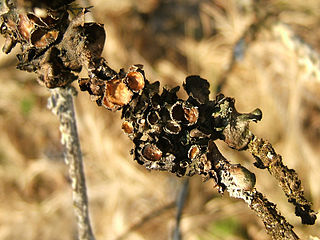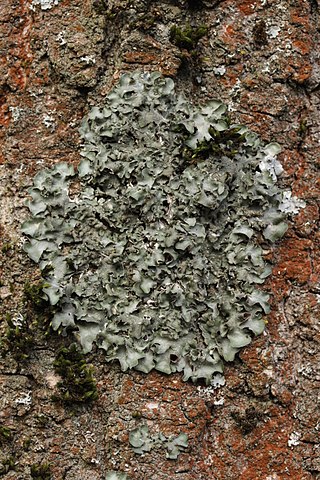
Cladonia is a genus of moss-like lichens in the family Cladoniaceae. They are the primary food source for reindeer/caribou. Cladonia species are of economic importance to reindeer-herders, such as the Sami in Scandinavia or the Nenets in Russia. Antibiotic compounds are extracted from some species to create antibiotic cream. The light green species Cladonia stellaris is used in flower decorations.

Muellerella is a genus of lichenicolous lichens in the family Verrucariaceae. The genus has a widespread distribution, especially in northern temperate areas, and contains species that live on other lichens, or on liverworts.

Pleurosticta is a genus of lichen belonging to the family Parmeliaceae. It has two species. The genus was circumscribed by mycologist Franz Petrak in 1931, with Pleurosticta lichenicola assigned as the type species. This is now known as a synonym of P. acetabulum.
Helicobolomyces is a genus of lichenized fungi in the family Arthoniaceae. This is a monotypic genus, containing the single species Helicobolomyces lichenicola.

Bruchidius is a genus of beetles in the bean weevil subfamily (Bruchinae) of the leaf beetle family, Chrysomelidae. Most are native to the Old World.

Cetraria aculeata or the spiny Iceland lichen is a dark brown to black fruticose, soil Iceland lichen from the family Parmeliaceae. The species was first described by German naturalist Johann Christian Daniel Edler von Schreber in 1771 under the name of Lichen aculeatus. Later on, Erik Acharius, the "father of lichenology" gave it a name of Cornicularia aculeata, which lately has been changed to Coelocaulon aculeatum. Finally, the taxonomic revision of Ingvar Kärnefelt and colleagues assigned the species to the genus Cetraria.

Leucogyrophana is a genus of fungi in the family Hygrophoropsidaceae. The genus was erected in 1958 to accommodate the species then known as Merulius molluscus. Several more species were described, but DNA testing in 2001 found that L. mollusca was isolated genetically from the others, and most closely related instead to Hygrophoropsis.

Lecanora polytropa, the granite-speck rim lichen, is a species of saxicolous (rock-dwelling), crustose lichen in the family Lecanoraceae. A small, inconspicuous species that grows in the cracks of rock surfaces, it has a cosmopolitan distribution and has been recorded on all continents, including Antarctica.

Lichenoconium is a genus of fungi belonging to the family Lichenoconiaceae.

Cladonia glauca or the glaucous cup lichen is a species of fruticose, cup lichen in the family Cladoniaceae. Found in Europe, it was formally described as a new species in 1828 by German botanist Heinrich Gustav Flörke. The nematodes Aphelenchoides lichenicola and Ottolenchus cabi feed on this lichen.

Pleurosticta acetabulum is a species of foliose lichen in the family Parmeliaceae. It is common and widespread throughout Europe, where it grows on tree bark. It has also been recorded in Algeria.

Cladonia macilenta or the lipstick cup lichen is a species of cup lichen in the family Cladoniaceae.

Muellerella lichenicola is a species of lichenicolous fungus in the family Verrucariaceae. It was first formally described as a new species in 1826 by Søren Christian Sommerfelt, as Sphaeria lichenicola. David Leslie Hawksworth transferred it to the genus Muellerella in 1979.

Variospora aurantia is a species of lichen belonging to the family Teloschistaceae. In Sicily, it has been reported as a host for the lichenicolous fungus species Muellerella lichenicola.

Lichenoconium pyxidatae is a species of lichenicolous fungus belonging to the class Dothideomycetes. It has a Holarctic distribution being found in Alaska and various parts of Russia, including Siberia, Franz Josef Land, Novaya Zemlya and Wrangel Island.

Cladonia pocillum is a species of lichen in the family Cladoniaceae. Swedish botanist Erik Acharius first formally described the species in 1803 as Baeomyces pocillum, but Olivier Jules Richard transferred it to the genus Cladonia in 1877.
Crittendenia is a genus of lichenicolous (lichen-dwelling) fungi in the monogeneric family Crittendeniaceae. The genus was circumscribed in 2021 to contain two species, C. lichenicola, and the type, C. coppinsii. An additional 16 species were added to the genus the following year. The genus name honours British lichenologist Peter Crittenden.
Rhagadostoma is a genus of fungi in the family Nitschkiaceae. All species in the genus are lichenicolous, meaning they live parasitically on lichens.
Watsoniomyces is a single-species fungal genus in the family Lichinaceae. It contains the saxicolous (rock-dwelling) crustose lichen Watsoniomyces obsoletus.
Candelariella lichenicola is a rare species of lichenicolous (lichen-dwelling) fungus in the family Candelariaceae. This species was first found in Sonora, Mexico, and is characterised by its distinct spore shape and chemical composition. It is typically found growing on the lichen species Candelina submexicana, and while not widespread, it contributes to the ecological diversity of the regions it inhabits.














